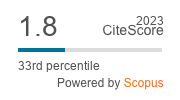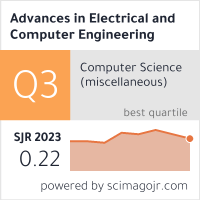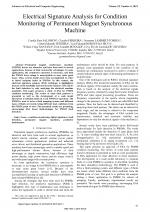| 4/2018 - 11 |
| View the paper record and citations in |
| Click to see author's profile in |
| Download PDF |
Author keywords
condition monitoring, digital signatures, fault detection, permanent magnet machines, predictive maintenance
References keywords
synchronous(9), stator(9), fault(9), detection(8), power(7), motors(7), permanent(6), magnet(6), electronics(6), induction(5)
Blue keywords are present in both the references section and the paper title.
About this article
Date of Publication: 2018-11-30
Volume 18, Issue 4, Year 2018, On page(s): 91 - 98
ISSN: 1582-7445, e-ISSN: 1844-7600
Digital Object Identifier: 10.4316/AECE.2018.04011
Web of Science Accession Number: 000451843400011
SCOPUS ID: 85058807078
Abstract
Permanent magnet synchronous machines (PMSMs) drives are attractive and have been used in several applications, because of their noteworthy advantages. In some applications, the continuous operation is necessary, and then the PMSM drive outage is unacceptable or may cause great losses. Thus, several studies have been accomplished in order to detect incipient faults in PMSMs. In this context, the electrical signature analysis (ESA) technique is highlighted, because of the feasibility and non-invasive features. ESA allows the fault detection by only analyzing the electrical machine quantities. This paper proposes a study of ESA for PMSM condition monitoring. The review of some fault patterns is presented as well as the development of a scale model laboratory to simulate faults in a real PMSM in operation. The PMSM is used to drive a fluid pumping system, and different types of fluids are tested, being different load conditions from the PMSM point of view. The presented results are promising, encouraging ESA based methodologies for PMSM fault detection. |
| References | | | Cited By «-- Click to see who has cited this paper |
| [1] D. Reljic, D. Jerkan, D. Marcetic, Dj. Oros, "Broken bar fault detection in IM operating under no-load condition," Advances in Electrical and Computer Engineering, vol. 16, no. 4, pp. 63-70, 2016, [CrossRef] [Full Text] [Web of Science Times Cited 12] [SCOPUS Times Cited 11] [2] A. G. Espinosa, J. A. Rosero, J. Cusidó, L. Romeral, J. A. Ortega, "Fault detection by means of Hilbert-Huang transform of the stator current in a PMSM with demagnetization," IEEE Transactions on Energy Conversion, vol.25, no.2, pp.312-318, June 2010, [CrossRef] [Web of Science Times Cited 176] [SCOPUS Times Cited 217] [3] J. C. Urresty, J. R. Riba, L. Romeral, "Diagnosis of interturn faults in PMSMs operating under nonstationary conditions by applying order tracking filtering," IEEE Transactions on Power Electronics, vol.28, no.1, pp.507-515, Jan 2013, [CrossRef] [Web of Science Times Cited 115] [SCOPUS Times Cited 134] [4] H. Saavedra, J. R. Riba, L. Romeral, "Detection of inter-turn faults in five-phase permanent magnet synchronous motors," Advances in Electrical and Computer Engineering, vol.14, no.4, pp.49-54, 2014, [CrossRef] [Full Text] [Web of Science Times Cited 11] [SCOPUS Times Cited 15] [5] D. Matic, Z. Kanovic, "Vibration based broken bar detection in induction machine for low load conditions," Advances in Electrical and Computer Engineering, vol.17, no.1, pp.49-54, 2017, [CrossRef] [Full Text] [Web of Science Times Cited 8] [SCOPUS Times Cited 11] [6] E. L. Bonaldi, L. E. L. de Oliveira, J. G. Borges da Silva, G. Lambert-Torres, L. E. Borges da Silva, "Predictive maintenance by electrical signature analysis to induction motors," in Induction Motors-Modelling and Control, Rui Araujo, Eds., Rijeka, Croatia: InTech, 2012, pp.487-520, ISBN 978-953-51-0843-6, [CrossRef] [7] C. P. Salomon, W.C. Santana, G. Lambert-Torres; L. E. Borges da Silva, E. L. Bonaldi, L. E. de Oliveira, J. G. Borges da Silva, A. L. Pellicel, G. C. Figueiredo, M. A. A. Lopes, "Discrimination of Synchronous Machines Rotor Faults in Electrical Signature Analysis based on Symmetrical Components," IEEE Transactions on Industry Applications, vol.53, no.3, pp.3146-3155, May/June 2017, [CrossRef] [Web of Science Times Cited 18] [SCOPUS Times Cited 22] [8] J. Hang, J. Zhang, M. Cheng, S. Ding, "Detection and discrimination of open-phase fault in permanent magnet synchronous motor drive system," IEEE Transactions on Power Electronics, vol.31, no.7, pp.4697-4709, July 2016, [CrossRef] [Web of Science Times Cited 82] [SCOPUS Times Cited 100] [9] J. A. Rosero, L. Romeral, J. Cusido, A. Garcia, J. A. Ortega, "On the shortcircuiting fault detection in a PMSM by means of stator current transformations," Proc. 2007 IEEE Power Electronics Specialists Conference, IEEE PESC 2007, Orlando, pp.1936-1941, June 2007, [CrossRef] [Web of Science Times Cited 33] [SCOPUS Times Cited 51] [10] T. Boileau, N. Leboeuf, B. Nahid-Mobarakeh, F. Meibody-Tabar, "Stator winding inter-turn fault detection using control voltages demodulation," Proc. 2012 IEEE Transportation Electrification Conference and Expo, IEEE ITEC 2012, Dearborn, pp.1-6, June 2012, [CrossRef] [SCOPUS Times Cited 15] [11] J. C. Urresty, J. R. Riba, L. Romeral, "In?uence of the stator windings configuration in the currents and zero-sequence voltage harmonics in permanent magnet synchronous motors with demagnetization faults," IEEE Transactions on Magnetics, vol.49, no.8, pp.4885-4893, Aug 2013, [CrossRef] [Web of Science Times Cited 59] [SCOPUS Times Cited 60] [12] J. Hang, J. Zhang, M. Cheng, Z. Wang, "Fault diagnosis of mechanical unbalance for permanent magnet synchronous motor drive system under nonstationary condition," Proc. 2013 IEEE Energy Conversion Congress and Exposition, IEEE ECCE 2013, Denver, pp.3556-3562, Sept 2013, [CrossRef] [SCOPUS Times Cited 32] [13] W. le Roux, R. G. Harley, T. G. Habetler, "Detecting Rotor Faults in Low Power Permanent Magnet Synchronous Machines," IEEE Transactions on Power Electronics, vol.22, no.1, pp.322-328, 2007, [CrossRef] [Web of Science Times Cited 199] [SCOPUS Times Cited 240] [14] B. M. Ebrahimi, M. Javan Roshtkhari, J. Faiz, S. V. Khatami, "Advanced Eccentricity Fault Recognition in Permanent Magnet Synchronous Motors Using Stator Current Signature Analysis," IEEE Transactions on Industrial Electronics, vol.61, no.4, pp.2041-2052, April 2014, [CrossRef] [Web of Science Times Cited 181] [SCOPUS Times Cited 216] [15] J. Rosero, J. L. Romeral, J. Cusido, J. A. Ortega, A. Garcia, "Fault detection of eccentricity and bearing damage in a PMSM by means of wavelet transforms decomposition of the stator current," Proc. 2008 Twenty-Third Annual IEEE Applied Power Electronics Conference and Exposition, IEEE APEC 2008, Austin, pp.111-116, Feb. 2008, [CrossRef] [Web of Science Times Cited 28] [SCOPUS Times Cited 40] [16] C. P. Salomon, W. C. Santana, G. Lambert-Torres, L. E. Borges da Silva, E. L. Bonaldi, L. E. L. de Oliveira, "Comparison among Methods for Induction Motor Low-Intrusive Efficiency Evaluation Including a New AGT Approach with a Modified Stator Resistance", Energies, vol.11, no.4, pp.691-712, April 2018, [CrossRef] [Web of Science Times Cited 11] [SCOPUS Times Cited 14] [17] J. R. Cameron, W. T. Thomson, A. B. Dow, "Vibration and current monitoring for detecting airgap eccentricity in large induction motors," IEE Proceedings B - Electric Power Applications, vol.133, no.3, pp.155-163, May 1986, [CrossRef] [Web of Science Times Cited 293] [SCOPUS Times Cited 443] [18] J. Sottile, F. C. Trutt, A. W. Leedy, "Condition monitoring of brushless three-phase synchronous generators with stator winding or rotor circuit deterioration," IEEE Transactions on Industry Applications, vol.42, no.5, pp.1209-1215, Sep./Oct. 2006, [CrossRef] [Web of Science Times Cited 67] [SCOPUS Times Cited 94] [19] S. M. A. Cruz, A. J. M. Cardoso, "Stator winding fault diagnosis in three-phase synchronous and asynchronous motors, by the extended park's vector approach," IEEE Transactions on Industry Applications vol.37, no.5, pp.1227-1233, Sep./Oct. 2001, [CrossRef] [Web of Science Times Cited 333] [SCOPUS Times Cited 436] Web of Science® Citations for all references: 1,626 TCR SCOPUS® Citations for all references: 2,151 TCR Web of Science® Average Citations per reference: 81 ACR SCOPUS® Average Citations per reference: 108 ACR TCR = Total Citations for References / ACR = Average Citations per Reference We introduced in 2010 - for the first time in scientific publishing, the term "References Weight", as a quantitative indication of the quality ... Read more Citations for references updated on 2024-07-21 02:34 in 128 seconds. Note1: Web of Science® is a registered trademark of Clarivate Analytics. Note2: SCOPUS® is a registered trademark of Elsevier B.V. Disclaimer: All queries to the respective databases were made by using the DOI record of every reference (where available). Due to technical problems beyond our control, the information is not always accurate. Please use the CrossRef link to visit the respective publisher site. |
Faculty of Electrical Engineering and Computer Science
Stefan cel Mare University of Suceava, Romania
All rights reserved: Advances in Electrical and Computer Engineering is a registered trademark of the Stefan cel Mare University of Suceava. No part of this publication may be reproduced, stored in a retrieval system, photocopied, recorded or archived, without the written permission from the Editor. When authors submit their papers for publication, they agree that the copyright for their article be transferred to the Faculty of Electrical Engineering and Computer Science, Stefan cel Mare University of Suceava, Romania, if and only if the articles are accepted for publication. The copyright covers the exclusive rights to reproduce and distribute the article, including reprints and translations.
Permission for other use: The copyright owner's consent does not extend to copying for general distribution, for promotion, for creating new works, or for resale. Specific written permission must be obtained from the Editor for such copying. Direct linking to files hosted on this website is strictly prohibited.
Disclaimer: Whilst every effort is made by the publishers and editorial board to see that no inaccurate or misleading data, opinions or statements appear in this journal, they wish to make it clear that all information and opinions formulated in the articles, as well as linguistic accuracy, are the sole responsibility of the author.





